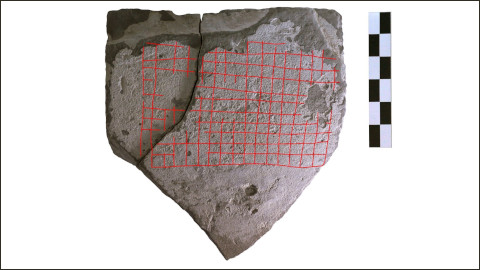Military strategy board game identified in the Roman fort of Biosca

A UAB research team publishes the discovery of a tabula lusoria dating back to the 2nd century BCE, discovered by an intern at the Roman fortress of Puig Castellar de Biosca, Lleida, in 2019. The board game, which almost without a doubt is the oldest to be discovered in a Roman military context, was found in its original place, an entertainment area for soldiers.
31/05/2021
In a study published in the journal Archivo Español de Arqueología, Esther Rodrigo and Núria Romaní, researchers at the Department of Antiquity and Middle Age Studies and members of the UAB group in charge of studying the Roman Republican fortress or castellum at Puig Castellar de Biosca (La Segarra, Lleida), have announced an exceptional discovery: a tabula lusoria (board game) from the 2nd century BCE, discovered by student of the Bachelor's Degree in Archaeology Francesc Sanahuja during the dig campaign of 2019.
The singularity of this discovery lies in where it was found: in a military complex belonging to the initial stages of the Roman conquest, dating from around 180 and 120 BCE, as well as for the fact that it was found in its original context and location, in one of the areas destined for soldiers. This has allowed them to affirm that it is one of the first correctly dated samples of a board game in the Iberian Peninsula. It also offers information on what the soldiers did in their free time, as well as the existence of Italic components, given that board games were still an unknown hobby among local soldiers at that time.
The tabula was found in its original position, well placed and set into the clay floor, detected thanks to incisions found on its surface. It was located in a room of large dimensions, possibly a living room, given the existence of two fireplaces.
An in-depth study of the board game indicates that the flagstone was of local origin, had a polygonal shape, and was whole except for some fractures. “Surely this was made by the soldiers themselves using a larger flagstone which was no longer useful so they gave the smaller piece a new purpose. It is very probable that these soldiers were building the castellum, and this is how they reused some of the building materials”, explains Núria Romaní.
The study describes a graticule of 11 x 16 squares (176 squares in total). “Based on parellels of the board game, we could venture to say that it was used to play ludus latrunculorum, or the game of mercenaries, which was a very popular military tactics game among soldiers. We have several examples of it, particularly in encampments chronologically located during the time of the Roman empire”, Esther Rodrigo points out. “This is the case of Vallum Adrianum, Vindolanda and Corbridge, as well as in Hispania, in the encampments found in the area of moder-day Galicia, Cantabria and Asturias, and the encampment of Petavonium in Zamora, the headquarters of the Legio X Gemina, the 'Twins' Tenth Legion'”.
The researchers explain that the rules to the game are not fully known, but that it was based on military tactics. And what is certain is that two opponents commanded two armies and the one to have the least number of pieces knocked off the board won. The strategy consisted in trying to corner, immobilise and capture the opponents' pieces until they surrender. It was a very popular game, especially among soldiers.
One of the oldest military fortresses of the Iberian Peninsula
The Roman Republican fortress or castellum at Puig Castellar de Biosca is considered to be one of the oldest Roman military architectural samples in the Iberian Peninsula. Located at a strategic height to control the roads passing through the area, and particularly one of the communication routes being built towards the Ebro Valley, a place of military conflicts in the 2nd century BCE. It was therefore a military settlement existing since the beginning of the conquest, which can be dated back to somewhere between 180 and 120 BCE. It is a fortified enclosure measuring 1.6 hectares with a building in the centre, interpreted by the research team as the command headquarters, and with a set of spaces built against the fort wall for sleeping, working and storing materials.
The team studying the castellum is formed by lecturers Joaquim Pera (main researcher of the project), Esther Rodrigo (co-main researcher of the project), Núria Romaní and César Carreras, and Laia Catarineu, pre-doctoral researcher at the Archaeology Unit of the Department of Antiquity and Middle Age Studies at the Faculty of Arts and Humanities of the Universitat Autònoma de Barcelona. The Catalan Institute of Classical Archaeology also collaborates in the research tasks.
Original article: Rodrigo Requena, E. ., & Romaní Sala, N. . (2021). Una tabula lusoria hallada en el castellum republicano de Puig Castellar de Biosca en Lleida, Catalunya (180-120 a. C.). Archivo Español De Arqueología, 94, e04. https://doi.org/10.3989/aespa.094.021.04